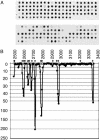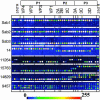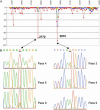Microarray analysis of evolution of RNA viruses: evidence of circulation of virulent highly divergent vaccine-derived polioviruses
- PMID: 12878723
- PMCID: PMC170930
- DOI: 10.1073/pnas.1633511100
Microarray analysis of evolution of RNA viruses: evidence of circulation of virulent highly divergent vaccine-derived polioviruses
Abstract
Two approaches based on hybridization of viral probes with oligonucleotide microarrays were developed for rapid analysis of genetic variations during microevolution of RNA viruses. Microarray analysis of viral recombination and microarray for resequencing and heterogeneity analysis were able to generate instant genetic maps of vaccine-derived polioviruses (VDPVs) and reveal the degree of their evolutionary divergence. Unlike conventional methods based on cDNA sequencing and restriction fragment length polymorphism, the microarray approaches are better suited for analysis of heterogeneous populations and mixtures of different strains. The microarray hybridization profile is very sensitive to the cumulative presence of small quantities of different mutations, including those that cannot be revealed by sequencing, making this approach useful for characterization of profiles of nucleotide sequence diversity in viral populations. By using these methods, we identified a type-3 VDPV isolated from a healthy person and missed by conventional methods of screening. The mutational profile of the polio strain was consistent with >1 yr of circulation in human population and was highly virulent in transgenic mice, confirming the ability of VDPV to persist in communities despite high levels of immunity. The proposed methods for fine genotyping of heterogeneous viral populations can also have utility for a variety of other applications in studies of genetic changes in viruses, bacteria, and genes of higher organisms.
Figures



References
-
- Domingo, E., Martinez-Salas, E., Sobrino, F., de la Torre, J. C., Portela, A., Ortin, J., Lopez-Galindez, C., Perez-Brena, P., Villanueva, N., Najera, R., et al. (1985) Gene 40, 1–8. - PubMed
-
- Domingo, E. & Holland, J. J. (1997) Annu. Rev. Microbiol. 51, 151–178. - PubMed
-
- Domingo, E., Escarmis, C., Menendez-Arias, C. & Holland, J. J. (1999) in Origin and Evolution of Viruses, eds. Domingo, E., Webster, R. & Holland, J. J. (Academic, San Diego), pp. 141–161.
Publication types
MeSH terms
Substances
LinkOut - more resources
Full Text Sources
Other Literature Sources

